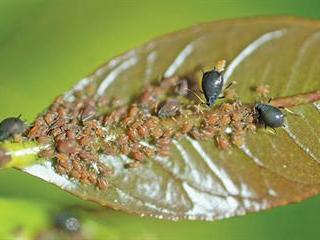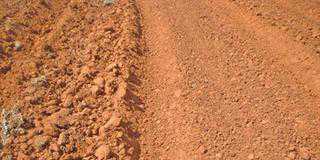
Scientific name: Toxoptera citricidus
Family: Aphididae
Distribution: The Americas and Africa
Winged forms (alates) and wingless (apterous) forms are the same size. The winged form has a dark brown or blackish abdomen, while the wingless form is blackish-brown, reddish-brown or black. Its antennae have black and white banding.
Like other aphids, this species is tended by ants that feed on the sugary liquid – honeydew – that it excretes. The aphid feeds on all varieties of citrus trees, as well as many vegetable and flower crops. Heavy infestations can cause buds to fall off, leaves to be shed, and stunting.
The honeydew excreted by the aphids may also coat the affected plant. This can result in a sooty mould fungus that spoils the fruit and weakens the plant, reducing its ability to photosynthesise. Black citrus aphids are also vectors for the Citrus tristeza virus (CTV).
Reproduction
As with most aphids, reproduction is asexual (parthenogenesis) and females produce offspring without mating. The higher the temperature, the shorter the life cycle, and vice versa. At high temperatures, the life cycle can be completed in about one week.
Control measures
- Chemical control: Most of the commercial insecticides used to control aphids work on contact – the insecticide must make direct contact with the aphid to be effective. When spraying, make sure the entire plant is covered, including the buds, and that there are no dry areas. This will ensure that hidden aphids will make contact with the insecticide as they move around the plant. Use Chlorpyrifos 4E, Chlorpyrifos 50W, organophosphates, carbamates, pyrethroids, neem products, or 1% to 2% insecticidal soap, to control varying levels of infestation.
- Natural predators: Many predators prey on aphids, including ladybirds and their larvae, lacewing larvae, tachinid flies, parasitic wasps, hoverfly larvae, tree crickets, young assassin bugs, and small spiders. For protection, aphids exude a wax-like substance from the rear of the abdomen. But this is not always effective. Natural predators may also be attracted by the ants that ‘farm’ the aphids for their honeydew.
- Other methods: Biological insecticides based on microbes are in the process of being developed. Research is also underway into chemicals that disrupt the aphids’ bodily functions such as respiration and digestion.
Results are promising. In wet or humid conditions, aphids can get fungal infections that can wipe out entire colonies. Fungal infection is evident when the aphids die and turn a brownish colour.
(Please note: this series is primarily a guide to identifying pests; the control methods discussed are merely suggestions. For help with area- or crop-specific measures, please consult your agricultural extension officer.) Paul Donovan is a biologist who advises farmers on the best methods to control crop pests.













